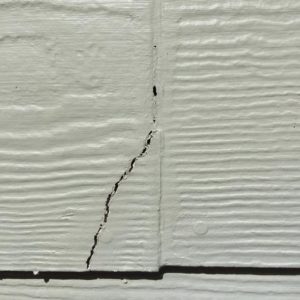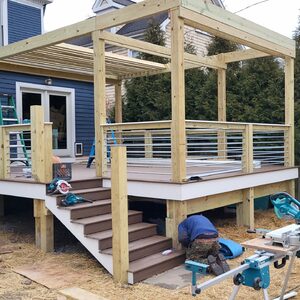The Case of the Sizzling Summer and Sorrowful Siding
Last week, I discovered that the fiber cement siding on the South side of my house is cracking at the corners of the boards in several places. In the past, there have been a few boards that did this, but now there are many.
We have had an unusually hot summer here in Northwest Oregon so I am thinking that may have contributed to this cracking. This South side takes a beating from the weather in the winter, as well. Do I need to have this South side resided? Or can it be repaired? Has anyone seen this happen before?
Thanks in advance for input!
Greta Girl




















Replies
Looks like the planks have shrunk. Structurally it's not a problem, so long as the larger cracks are caulked, but you have to decide on your own about the appearance.
could be bad nailing...
Looks like it is face nailed [which is my preference].It's impossible to tell for sure from the pics but could be it's nailed so low that the nail goes through the top of the underlying course.
FC siding doen't move a whole lot but it's not very flexible if it does.
Hard to tell for sure, but it looks like it's concealed nailing, except that the loose ends have been nailed down (so to speak).
Dont blame the weather.
FC was made for this kind of weather. Also, James Hardi's preferred installation method is blind nailng (not face) and not to caulk butt joints. Other manufacturers generally follow the same principles.
Face nailing is only recommended for high wind conditions (maybe you're one of them, but I doubt it) but never both blind and face nailing. You probably do not have both types of nailing in this install, but it's worth checking. The butt joints should be flashed and not caulk. Butt factory sealed edges if possible, not field cuts. Some people do caulk, but it looks like hell (as evidenced here) and rarely holds up. IMO, the cracks are fractures from nailing close to the edge. At these fragile nailing areas, it is wise to pre-drill and hand drive the fastener carefully. To me, it looks like these fractures happened upon original installation and were fudge repaired with caulk. Now, as the caulk is shrinking at the joint (not the FC) it is pulling the fractured piece towards it, thus revealing the installation flaw.
I would ask the installer to repair these areas and flash w/o caulk. If they won't, then ask for your money back and hire someone that will.
Two problems, face nailed too close to the bottom and the edge and the seam is caulked. You might get away with one of the two but not both. I'd pull those boards out and replace them. I'd also wait for a cool day to scrape and pull the caulk out of the joints so it doesn't keep happening.
I have never worked with fiber cement siding, and don't need to, so this question is simply out of curiosity. What is the concern about using caulk in between two adjacent pieces of fiber? Does this include all caulks... sticky/adhesive sorts and gap filling types?
good question
That's a good queston Sapwood.
1. You don't need it. All joints should be flashed.
2. Most fiber cement installed now is prefinished. If you're caulking for asthetic reasons, be aware that it difficult (if not impossible) to get a match; particualary as caulk pigments age. So, basically, you'll draw attention to the joint and you'll end up making it look worse than just butting the joint per manufacturer's preferred method.
3. Even the best caulks are good for only 3-5 years. When you see caulk advertised as 20, 30, or 50 year caulk, what is the warranty? The warranty is the material itself; not the mess you made by using it. That's just marketing hype where the manufacturer is looking for the biggest bang for the buck.
So, in a nutshell, you genearly caulk for 1 of 2 (and sometimes both) reason. Sealing and cosmetics. IMO, both don't apply very well to F.C. butt joint conditions.
BTW, all caulks are adhesive. They have to bond to the surfaces they are bridging otherwise they wouldn't work. Now you can talk about differnet caulk properties like paintability, elasticity, material compatibilty, etc. until the cows come home. But that's a different subject all together.
In answer to your question, unless the caulk is some sort of super epoxy-based stuff it makes no difference with regard to the cracking seen.
I know everyone will be shocked but you're totally wtrong once again. The caulk can make the FC crack as the pics the OP posted plainly show. Acrylic caulk is a super adhesive.
Yes; but....
Florida is correct; acrylic caulk is a super adhesive. However IMO it won't make the FC crack, per say, unless it has already been fractured by a nail that has created a fault line.
Again, in this case, I believe that a fault line (FC crack) was fudged at the time of original installation. If you look closely at the second photo you can see evidence of a surface bead that shrunk rsulting in a torn "adhesive "bridge" between both sides of the fracture. There's just too much body on either side of the fracture to be just paint.
How does this happen? Since the butt joint has more caulk body, it's adhesive bond (and ability to shrink) was greater and overcame the bridging capability of the "fudge" bead, thus pulling the fracture apart as the butt joint caulk shrank. It only took one hot summer to reveal this flaw.
If you search the web you'll find a lot of complaints about fiber-cement siding shrinking. This appears to be in part due to siding being delivered wet from the manufacturer (even James Hardie has done this, apparently) and in part simply inherent in FC siding.
Certainly wood siding shrinks as well, but wood is (much) more elastic than FC, so the stress does not end up all concentrated at the ends of the planks.
Likely the south side is showing this worse because the sun strikes it and warms it up, accelerating the drying process.
If the joints are flashed behind like they're supposed to be the shrinkage is not an immediate concern. However, many installers did not flash behind the joints (did yours?) and in many cases the "flashing" is simply builders felt ("tar paper") which will not stand up well to direct (ie, through the open joint) weather exposure.
This leaves you with a choice between replacement and caulking or otherwise closing up the open joints.
what?
Dan, you have no idea what you're talking about concerning FC shrinkage or wood shrinkage. Your input boils down to conjecture based on cursory internet searches. IMO, it's unprofessional to spread misinformation. There is nothing wrong with not knowing the cause or solution to the original posters concerns. Let it go. It certainly is no cause for throwing darts at the problem.
BTW, wood shrinks in 3 axis; longitudinal, tangential, & radial. Longitudinal shrinkage in wood is miniscule. In fact, you could probably throw a 2"x4"x8' KD stud into a pond and let it sit there for week without a change in length. It might be 1-5/8" thick x 3-3/4" wide at the end of the week, but it will still be 8' long. Any stress due to moisture change in wood is distributed throughout the grain. To talk about stress not being (or being) "at the ends" is just plain silly talk.